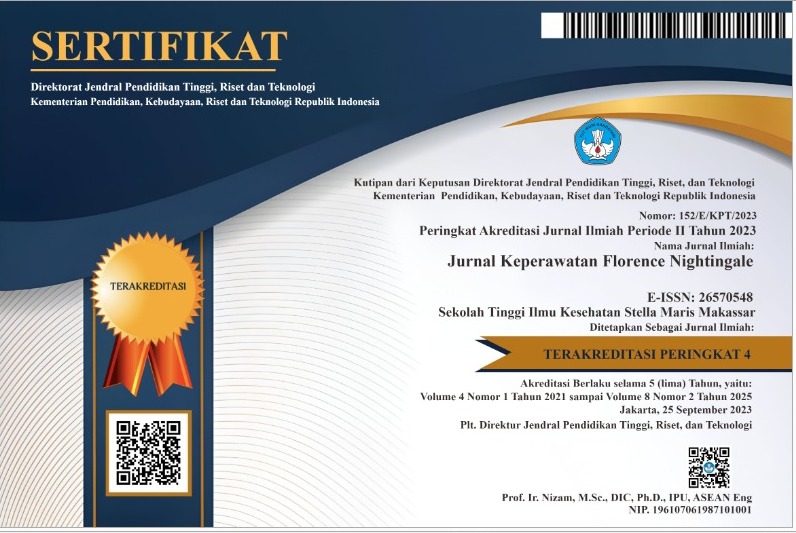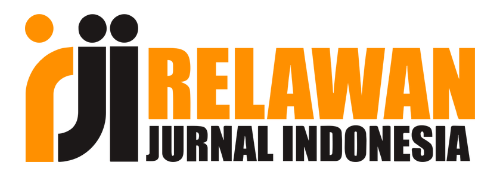Evaluation of Sucking Ice Cube and Frozen Fruit on Thirst in Congestive Heart Failure Patients Undergoing Fluid Restriction
Keywords:
ice cubes, Frozen Fruit, CHF, Thirst, fluidsAbstract
Fluid restriction in Congestive Heart Failure patients often causes intense thirst. Thirst resulting from a fluid restriction program in CHF patients can be overcome by stimulating saliva to keep the oral mucosa moist and reduce complaints of thirst. To reduce the thirst of CHF patients, one way that can be done is to suck ice cubes and frozen fruit. This study aims to compare the differences in thirst in CHF patients who suck ice cubes and suck frozen fruit. This research is quantitative research with a quasi-experimental approach with a pre and post-test design with control group. The research location will be carried out at Labuang Baji Regional Hospital, Makassar. Participants were selected using Consecutive Sampling techniques. The instrument that will be used is Visual Analog scale. The results of analysis using the Mann-Whitney test showed that the mean rank value for chewing ice cubes was 8.4 and for the frozen fruit group it was 22.7. There was a significant difference between the decrease in the intensity of thirst in the group sucking ice cubes and frozen fruit. Where the difference in average decrease in thirst in the ice cube group was greater than in the frozen fruit suckling group. The results of the Mann Whitney test also showed 0.000 (p < 0.05), it can be concluded that there is a difference in the effectiveness of sucking ice cubes and frozen fruit on thirst in Congestive Heart Failure patients undergoing a fluid restriction program at Stella Maris Hospital, Makassar
Downloads
References
Rasa Haus Pada Pasien Penyakit Ginjal Kronis Yang Menjalani Hemodialisa. 1–9.
Badan Peneliti dan Pengembangan Kesehatan Kementerian RI. (2013). Riset Kesehatan Dasar.
Igbokwe, V. U., & Obika, L. F. O. (2008). Thirst perception and dryness of mouth in healthy young adults Nigerians. African Journal Biomedical Research, 11(1), 39–46. https://doi.org/10.4314/ajbr.v11i1.50664
Lam. (2015). Heart Failure in Southeast Asia facts and Number. ESC Heart Failure, 2(2), 46–49.
Lemone, Burke, & Bauldoff. (2015). Buku Ajar Keperawatan Medikal Bedah, Vol 3 (5th ed.). EGC.
Lina, L. F., & Wahyu, H. (2019). Efektivitas Inovasi Intervensi Keperawatan Mengulum Es Batu Terhadap Skala Haus Pasien Hemodialisis. Jurnal Keperawatan Muhammadiyah Bengkulu, 7(2), 106–113. https://doi.org/10.36085/jkmu.v7i2.499
Peter Munk Cardiac Centre. (2016). Your Heart Failure and Fluid Restriction.
Pusdatin Kementerian Kesehatan RI. (2013). Data Penyakit Kardiovaskuler.
Rosaulina, M., & Indrayani, C. (2021). Pengaruh Terapi Ice Cubes Terhadap Penurunan Rasa Menjalani Hemodialisa Di Rsu Sembiring. 4(1).
Sujudi, M., Zuhri, A., & Kusumantoro, A. (2017). Efektivitas Fruit Frozen terhadap Keluhan Haus dan Mulut Kering pada Pasien CHF yang Menjalani Program Restriksi Cairan di Ruang UPJ RSUP Dr. Kariadi Semarang. Medica Hospitalia?: Journal of Clinical Medicine, 2(3), 156–161. https://doi.org/10.36408/mhjcm.v2i3.189
WHO. (2015). Cardiovascular Disease. World Health Organization.
Published
How to Cite
Issue
Section
Copyright (c) 2024 Yunita Carolina Satti, Fransisco Irwandy

This work is licensed under a Creative Commons Attribution-ShareAlike 4.0 International License.









